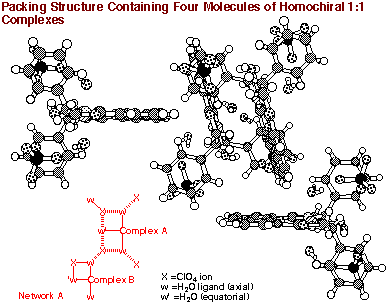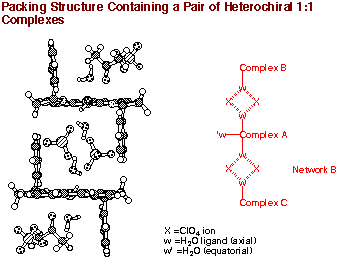
C03 Chiral Amplification by Formation of Heterochiral Oligomer (Mechanism 02)
Relative Stability of Two Oligomeric Forms of 1:1 Complexes:
What is the second chirality
enrichment mechanism operating in the solution? Most likely some heterochiral
pairs of the 1:1 complex DBFOX/Ph´Ni(ClO4)2´3H2O are formed or they are
durther associated to form relatively stable racemic aggregation, while
weak aggregation should result in the case of enantiopure 1:1 complex. The
aqua ligands apparently play an improtant
role in the chirality enrichment process, increasing
stability of the associated heterochiral oligomers. For example, the Diels-Alder
reaction using the anhydrous complex (20% ee, 10 mol%) prepared from DBFOX/Ph,
NiBr2, and AgClO4 (1/1/2 molar ratio) only results in a low chiral amplification
(23% ee for endo-8). When enantiopure 1:1 aqua complexes, R,R- and S,S-DBFOX/Ph´Ni(ClO4)2´3H2O,
are mixed in a ratio of 6 and 4 mol%, respectively, and used in the Diels
Alder reaction at room temperature, a 94% ee is observed for the endo-cycloadduct.
This indicates that the chiral enrichment mechanism working in the solution
is much more effective.

Oligomeric Structure of Homochiral 1:1 Complex:
In order to estimate the intermolecular interactions
in homochiral and heterochiral aggregations of 1:1 complexes, the single
crystals in each case were prepared. The X-ray structure of enantiopure
1:1 complex R,R-DBFOX/Ph´Ni(ClO4)2´3H2O was already shown above. On the
other hand, single crystals of heterochiral pairs were prepared by the following
procedure. Equivalent amounts of each enantiopure 1:1 complexes R,R- and
S,S-1:1 complexes (DBFOX/Ph´Ni(ClO4)2´3H2O) were dissolved in dichloromethane
containing acetone as cosolvent. After these two solutions were mixed, benzene
was added. Slow evaporation of the relatively more volatile dichloromethane
and acetone gave single crystals of racemic 1:1 complex. Single crystals
prepared from enantiopure R,R-1:1 complexes include four molecules in a
unit cell, in which two each are parallel with a layer distance of 7.41
A. We assume that intermolecular attractive interactions should be working
through hydrogen bonds between the water ligands and perchlorate ions in
the network. Measurement of the oxygen - oxygen distances between water
ligand and perchlorate ion should be informative. However, the perchlorate
ion has a spherical shape with high mobility so that temperature factor
for this anion is relatively big. Accordingly, we used the distance between
a chlorine atom of perchlorate and an oxygen atom of water to evaluate hydrogen
bond interactions. We hypothesize that such an attractive interaction should
exist when the distance is shorter than 4 A. Each perchlorate ion is bonded
with an equatorial and an axial water ligands of the same molecule of 1:1
complex and these axial waters are bonded with perchlorate ions which belong
to the adjacent molecules (Network A, the oxygen - chlorine distances are
3.91, 3.79, 3.75, 3.72, and 3.67 A). As a result, the two adjacent R,R-1:1 complexes are linked with one hydrogen
bond.

Oligomeric Structure of Heterochiral 1:1 Complex:
On the other hand, in the single crystals
prepared from equivalent amounts of heterochiral 1:1 complexes, R,R- and
S,S-DBFOX/Ph´Ni(ClO4)2´3H2O, a pair of two heterochiral 1:1 complexes are
incorporated in a unit cell to form a layered structure with alternate layer
distances of 7.33 and 7.6 A. Two perchlorate ions stay in the nallower gap,
and two additional acetone molecules as crystallization solvent occupy the
wider gap. The perchlorate ions interact with two axial water ligands by
hydrogen bonds (3.71 and 3.77 ! to construct a layered structure. The adjacent
two molecules of heterochiral 1:1 complexes, R,R- and S,S-DBFOX/Ph´Ni(ClO4)2´3H2O,
interact with each other by two hydrogen
bonds per one complex molecule. This suggests that
heterochiral aggregation should be much stronger than the above homochiral
case. We believe that the 1:1 complex R,R-DBFOX/Ph´Ni(ClO4)2´3H2O (supposed
to be major enantiomer) would interact, even in the solution, with heterochiral
1:1 complex S,S-DBFOX/Ph´Ni(ClO4)2´3H2O much stronger than homochiral 1:1
complex R,R-DBFOX/Ph´Ni(ClO4)2´3H2O. As a result, the minor complex is deactivated
in the solution to enrich the major enantiomer of 1:1 complex R,R-DBFOX/Ph´Ni(ClO4)2´3H2O.
This is the mechanism for effective chiral amplification occurring in the
solution. Such differential of stabilization of oligomeric forms is supported
by the following observation: Crystals of the enantiopure 1:1 complex rapidly
dissolve in dichloromethane when treated with 3-acetyl-2-oxazolidine, while
those of racemic complex are not soluble even under harder conditions.